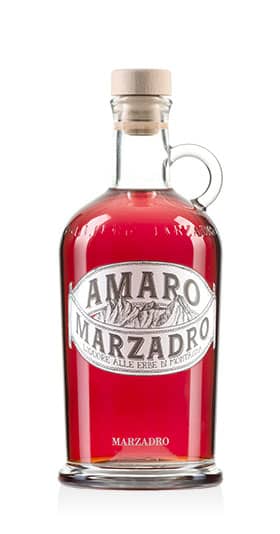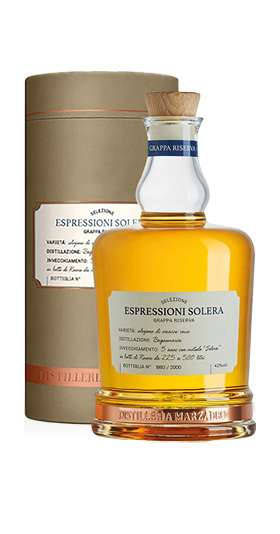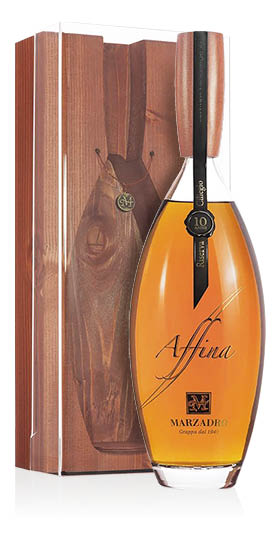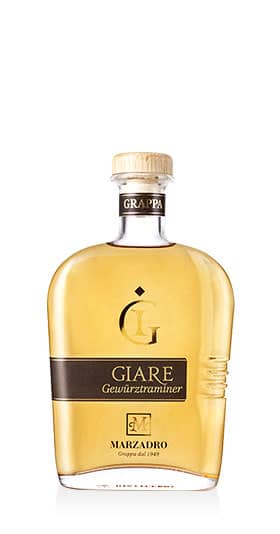Marzadro
The history of the Marzadro Distillery is closely intertwined with the history of the Italian post-war period. In Trentino , the war had hit the economy and the population hard, the girls of the small villages, in order to survive, went "to service" with wealthy families also in other parts of Italy. Sabina Marzadro had the same fate, but on her return to Trentino, she decided to follow her dreams and to undertake the art of distillation. His goal was clear: to distil quality Grappa. With effort and sacrifice he managed to have an alembic built and in 1949 the first pomace finally arrived to start production. Grappa Marzadro soon became famous throughout the village and production began to grow, with Sabina and her brother Attilio at the head of the distillery. In 1960 Sabina left the distillery in the hands of her brother and wife Teresa, the change of management also corresponded to a subsequent renewal of the plant and of the company. Attilio's family grew rapidly so much so that the children soon began to help their parents in the management of the distillery. In 1975 the Marzadro Distillery created the first single-variety Grappa, obtained from Marzemino grape marc. At the end of the seventies, the copper stills of the Marzadro Distillery were already in Bagnomaria, a great innovation in the world of distillation, since prolonged heating enriched the vapor with aromas. In the eighties, after the company passed from Attilio to his sons, the Grappa crisis began. The world had changed, big brands and advertising dominated the market. Attilio's heirs acted quickly by creating a new type of product that better respond to market demands. The grappa-based liqueur was produced with blueberries from Trentino. After the great Grappa crisis, Marzadro continued to grow and the Rovereto site was added to the original Brancolino distillery. Today, the third generation is at the helm of Marzadro, the head office has been moved to Nogaredo and the family has been and continues to be the beating heart of the company.
Grappa Marzadro
Grappa Marzadro is the result of a distillation that lasts continuously for 100 days, from September to December. The distilled pomace comes from the indigenous grape varieties of Trentino, are carefully selected and then distilled in a bain-marie, in a discontinuous alembic still. Marzadro's copper stills are artisanal and the whole distillation process is controlled with advanced systems. The Marzadro Grappas differ in aromaticity, aromas and flavors, even if elegance, character and softness are the traits that unite them all. On Vino.com you will find a wide selection of Marzadro Grappa : the Young Traditional Trentino, with its strong notes and the scents of alpine herbs from Trentino; the Grappa Affina Riserva Ciliegio, elegant, sweet and complex; Grappa Stravecchia Le Diciotto Lune, produced for the first time in 2002, obtained from the best pomace of Trentino, aged for at least 18 months and characterized by a full and round taste. Discover all the Marzadro Spirits and their characteristics.
What are the characteristics of Grappa Marzadro Giare Amarone?
Grappa Giare Amarone is obtained by distilling the pomace of Amarone della Valpolicella : Corvina , Rondinella and Molinara in a bain-marie, in a discontinuous alembic still. It is a fine and elegant Grappa, with strong aromas and a velvety flavor. Grappa Giare is enveloping, it is aged 36 months in small barrels, acquiring an extraordinary harmony and persistence. Discover all the features on Vino.com.
What are the characteristics of Grappa Marzadro Fieno?
Grappa Fieno Marzadro is obtained from the infusion in alcohol of cut and dried hay from the mountain meadows of Trentino. It has an extremely floral scent, delicate and aromatic notes and an enveloping taste.
What are the characteristics of Grappa Marzadro based on chamomile?
Grappa Camilla, is the Marzadro distillate based on Chamomile. Its main ingredient is chamomile, which is harvested in the meadows in the Trentino mountains and then cold macerated for 30 days in Grappa. The resulting distillate combines the characteristics of Grappa with the aromatic notes of chamomile, creating a light and ideal liqueur at the end of a meal. The olfactory profile of Grappa Camilla is very floral and aromatic, while its taste profile is particularly delicate and enveloping. Discover the details of Grappa Camilla on Vino.com.













